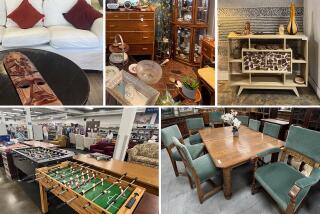It Helps to Know How to Look for Riches at a Salvage Yard
- Share via
Architectural salvage yards may not be everyone’s first choice for a home decor shopping expedition. Items are stacked against walls, on shelves, sorted into boxes or baskets, sometimes caked with dust or covered in rust.
But for the intrepid treasure seeker, they can be paradise.
Architectural salvage yards stock items left over from residential and commercial remodels and demolitions. Some also carry consignment pieces. Others concentrate on specific categories and eras, from vintage and antique hardware to modern plumbing fixtures to garden items.
Architectural Detail in Pasadena specializes in architectural pieces from 1900 to 1950. Owner Skip Willett, whose background is in building restoration, carries everything from wrought-iron gate pieces to windows, doors, antique hardware, stained glass, lumber, bricks, lighting, tile, old cabinets and bathtubs. Prices range from a few dollars for a drawer pull to $50 for a wrought-iron piece or $500 for a large cabinet in need of repair.
His customers are students, architects, homeowners and decorators, some searching for just the right arts and crafts door handle, others for authentic versions of reproductions found in upscale decor catalogs such as Ballard Designs.
“I want to keep the stuff out of the dump. I want it to be used,” says Willett, who admits he’s a stickler for staying true to architectural styles and eras.
“I’m sure there are things that Fred does that I probably wouldn’t approve of,” says Willett of Fred Balak, a local furniture designer. “But we’ll talk about it. We get along.”
Balak, who uses salvage pieces in his cabinets, chests and tables, offers this advice when stalking the salvage yard: “Don’t be in a hurry. You can’t be on your way to Old Town [in Pasadena] and run in for five minutes. You really need to look around and let your mind wander and play with things.”
He also advises taking someone else along to offer ideas and suggestions.
Some other things to keep in mind:
* If you’re not familiar with a salvage yard, call ahead to see what it specializes in. If you’re looking for a specific item, ask if the item is carried.
* You don’t have to be an expert craftsperson or woodworker to use something from a salvage yard. Rusted wrought-iron pieces or scraps of molding can serve as art objects on a shelf or against a wall. Think about creating a still life using these pieces and other items you already own.
* Don’t dismiss something because it has flaws. Chipped paint, cracks and rust are desirable features for vintage and antique pieces. If you fall in love with something like a cabinet that needs serious repair, buy it only if you intend to have it fixed by an expert. Otherwise, it may sit around your garage gathering dust.
* Take along a notebook and tape measure. Make notes or sketches about pieces you’re interested in and their dimensions. If dust and dirt bother you, also take along some hand cleaner or wipes.
* If you see an item and you’d like 20 more just like it, ask the owner--he might have more available.
* Since stock changes constantly at salvage yards, it’s wise to revisit them.
Here are some salvage yards in the area:
Architectural Detail
512 S. Fair Oaks Ave.
Pasadena
(626) 844-6670
Scavenger’s Paradise
5453 Satsuma Ave.
North Hollywood
(323) 877-7945
Santa Fe Wrecking Corp.
1600 S. Santa Fe Ave.
Los Angeles
(213) 623-3119
Ruins
7220 Beverly Blvd.
Los Angeles
(323) 934-4396
Also in Orange County:
1233 N. Pacific Coast Highway
Laguna Beach
(949) 376-0025
Manchester Sash & Door
(specializes in locks)
1228 W. Manchester Ave.
Los Angeles
(323) 759-0344
For information on Fred Balak’s furniture, call (213) 627-7719.
More to Read
Sign up for The Wild
We’ll help you find the best places to hike, bike and run, as well as the perfect silent spots for meditation and yoga.
You may occasionally receive promotional content from the Los Angeles Times.






